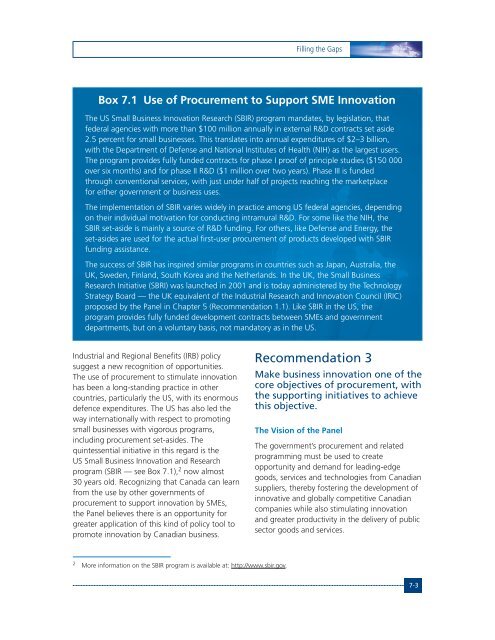Innovation Canada: A Call to Action
Innovation Canada: A Call to Action
Innovation Canada: A Call to Action
You also want an ePaper? Increase the reach of your titles
YUMPU automatically turns print PDFs into web optimized ePapers that Google loves.
Filling the GapsBox 7.1 Use of Procurement <strong>to</strong> Support SME <strong>Innovation</strong>The US Small Business <strong>Innovation</strong> Research (SBIR) program mandates, by legislation, thatfederal agencies with more than $100 million annually in external R&D contracts set aside2.5 percent for small businesses. This translates in<strong>to</strong> annual expenditures of $2–3 billion,with the Department of Defense and National Institutes of Health (NIH) as the largest users.The program provides fully funded contracts for phase I proof of principle studies ($150 000over six months) and for phase II R&D ($1 million over two years). Phase III is fundedthrough conventional services, with just under half of projects reaching the marketplacefor either government or business uses.The implementation of SBIR varies widely in practice among US federal agencies, dependingon their individual motivation for conducting intramural R&D. For some like the NIH, theSBIR set-aside is mainly a source of R&D funding. For others, like Defense and Energy, theset-asides are used for the actual first-user procurement of products developed with SBIRfunding assistance.The success of SBIR has inspired similar programs in countries such as Japan, Australia, theUK, Sweden, Finland, South Korea and the Netherlands. In the UK, the Small BusinessResearch Initiative (SBRI) was launched in 2001 and is <strong>to</strong>day administered by the TechnologyStrategy Board — the UK equivalent of the Industrial Research and <strong>Innovation</strong> Council (IRIC)proposed by the Panel in Chapter 5 (Recommendation 1.1). Like SBIR in the US, theprogram provides fully funded development contracts between SMEs and governmentdepartments, but on a voluntary basis, not manda<strong>to</strong>ry as in the US.Industrial and Regional Benefits (IRB) policysuggest a new recognition of opportunities.The use of procurement <strong>to</strong> stimulate innovationhas been a long-standing practice in othercountries, particularly the US, with its enormousdefence expenditures. The US has also led theway internationally with respect <strong>to</strong> promotingsmall businesses with vigorous programs,including procurement set-asides. Thequintessential initiative in this regard is theUS Small Business <strong>Innovation</strong> and Researchprogram (SBIR — see Box 7.1), 2 now almost30 years old. Recognizing that <strong>Canada</strong> can learnfrom the use by other governments ofprocurement <strong>to</strong> support innovation by SMEs,the Panel believes there is an opportunity forgreater application of this kind of policy <strong>to</strong>ol <strong>to</strong>promote innovation by Canadian business.Recommendation 3Make business innovation one of thecore objectives of procurement, withthe supporting initiatives <strong>to</strong> achievethis objective.The Vision of the PanelThe government’s procurement and relatedprogramming must be used <strong>to</strong> createopportunity and demand for leading-edgegoods, services and technologies from Canadiansuppliers, thereby fostering the development ofinnovative and globally competitive Canadiancompanies while also stimulating innovationand greater productivity in the delivery of publicsec<strong>to</strong>r goods and services.2 More information on the SBIR program is available at: http://www.sbir.gov.7-3
















